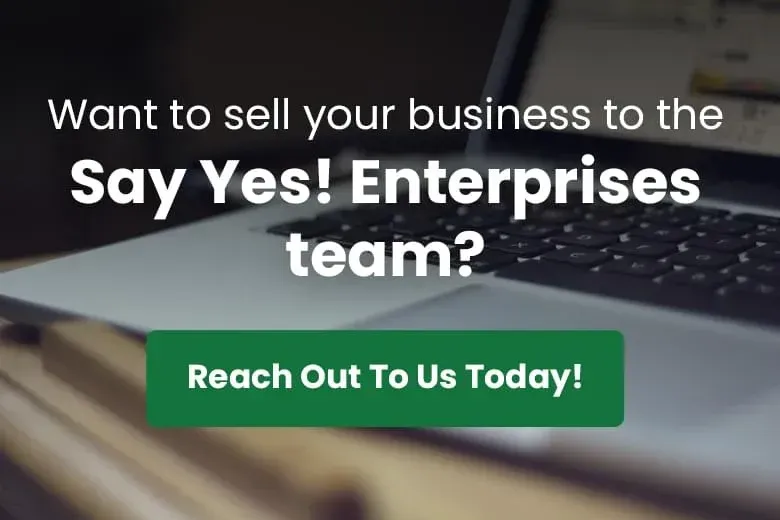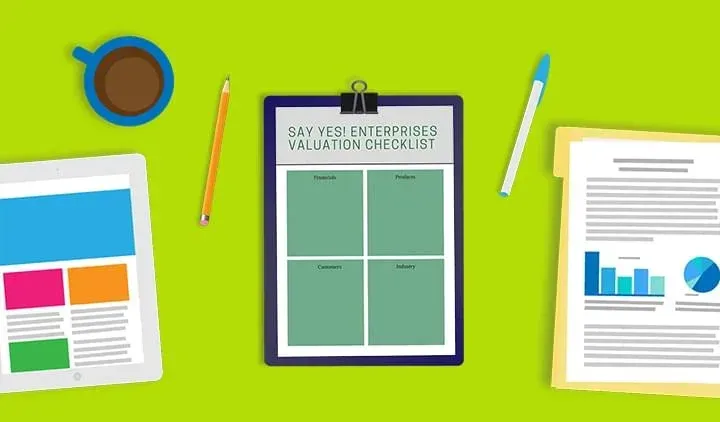Top Four Reasons Investors Choose Say Yes! Enterprises
Written by Marissa B. on October 13th, 2020

An Interview With Christopher Wick, Investor & Chairman of Say Yes! Enterprises
Want great returns on your investment?
Overwhelmed with the lack of credible options, disappointing returns and unfair risk?
Welcome to Say Yes! Enterprises.
Say Yes! Enterprises was founded by Christopher Wick, a Texas-based serial entrepreneur. He has years of experience acquiring, building, and selling successful businesses. After helping 400+ businesses in his international award-winning marketing agency, Wick began a full-time career in merger and acquisitions.
Say Yes! Enterprises (SYE) was formed to create consistent investment returns by acquiring low risk businesses. While many people dream of starting a business, SYE avoids the risks of start-ups and invests only in existing businesses with proven track record, proven cash flow and proven profitability.
Why invest in a startup that has up to a 90% chance of failure? Source: Medium
Only 30% of businesses survive until their 10th year. That’s surviving -- not necessarily profitably. Source: National.Biz
Investing in existing businesses with SYE requires a simple mindset shift. We’re not looking for the next “big” idea or the next unicorn. We’re looking for what’s already working.
If there was a 90% chance your plane would crash, would you ever fly?
Of course not.
Thus, the beneficial mindset shift to investing in existing businesses reduces risk. Statistics show that after the first few volatile years, survival rates flatten out. Source: SBA
Wick has experienced both sides of business acquisitions as both the buyer and the seller. He understands the unique needs of investors who want to grow their portfolio and the lack of credible resources (and risky) available for them. While understanding the needs of business sellers, see article “Top Four Reasons Sellers Choose Say Yes! Enterprises” The desire for consistent returns and lower risk investment options were behind the founding formation of starting SYE.
The first SYE acquisition was a popular eCommerce store in 2018. After increasing the company’s valuation 47.78%, SYE re-sold it to another investor for a considerable profit.
The acquisition process focused on staff optimization by tripling the staff, increasing revenues by 32.43% and growing the profitability of the company by 18.18%. The entire process of growing and selling the store took less than 11 months.
Whether you’re “flipping” businesses or acquiring businesses to “buy and hold” investors can work with SYE to enjoy a similar success.
Here are the four reasons why investors choose Say Yes! Enterprises:
#1 - Understanding The Seller’s Needs
The best of acquisitions can fall apart if there are communication problems or a lack of mutual respect. That is why Wick keeps the seller’s unique needs in mind when structuring deals. He creates win-win situations.
“Special circumstances are usually what’s prompted the sale of the business in the first place. Where I’m able to add more value than traditional business buyers is my depth of understanding of what it’s like to be on the other side of the table as the seller. Sellers have needs. If a buyer doesn’t address those needs, they’ll most certainly either lose the deal or have an unpleasant transaction,” Wick says.
Investors will never make a return on a deal that never makes it to the closing table. In the first acquisition that SYE made in 2018, SYE offered less money than other potential investors for the eCommerce acquisition, but the seller still chose SYE. Why?
“Most sellers aren’t just seeking the most money: they're seeking the most certainty and trust of who they’ll be working with,” Wick explains.
This kind of insight is pivotal to managing the human aspect of an acquisition. It can make or break a deal. At SYE, deals close in a three-phase process that includes discovery, valuation and offer acceptance.
In addition to understanding the seller’s needs, it’s also vital to understand the seller’s attachment to their company’s customers.
As a talented marketer and serial entrepreneur, Wick has learned plenty of lucrative lessons over the years.
Wick has learned that going above and beyond for every customer goes a long way. That is why with his first acquisition, he immediately allowed customers to contact the company support staff by phone, email or text, therefore doubling customer support options. Combined with customer satisfaction surveys and rewards for repeat customers, these changes led to more profitability.
In addition to the seller’s unique needs and their attachment to the company’s customers, it’s also important to understand the brand significance to the seller. Sellers want something they can be proud of and they’ll choose the investor that has the largest likelihood of propelling their brand forward.
One of the ways Wick added brand value to the eCommerce store was by assigning a “face” to the brand, through the use of a cartoon character named Tracy. People trust people, even if that person is simply a cartoon or a fictional character. This technique can be shown by looking at the gecko in Geico, ‘Flo’ with Progressive Insurance, and the clown in McDonald’s.
The reasons stated above are just a few of the changes that were implemented in taking an existing business from “good” to “Great!”
#2 - Accurate Company Valuations & Investment Opportunity
If you make an improper valuation of a company, it can be outstandingly difficult to get a strong return on investment. Much like buying a house, when you invest in a company, you need to be strategic and mindful about your offer to acquire the company.
SYE bases valuations on EBITDA or SDE valuations at industry-specific multiples. These fair valuations consider concrete numbers, industry data, and business performance. Along with financial performance indicators, SYE also attaches a monetary value to ‘intangibles.’
Some assets simply do not show up within a profit and loss statement, and Wick has a keen eye for recognizing these intangible valuables. For example, a large customer list and social media following proved valuable for marketing efforts in increasing the valuation of his first eCommerce acquisition.
In addition to avoiding overvaluation of companies, investors also have to be careful when making offers to sellers.
If too low of an offer is given, a buyer risks offending the business seller, damaging the relationship, and losing the deal. One of the most important factors within an acquisition is a fair offer that provides a positive outcome for both the buyer and seller.
The valuation phase in the acquisition process covers key areas, such as, but not limited to: financial performance, business assets, revenue sources, return customer rate and the ability to scale.
Oftentimes, sellers will overvalue their businesses due to emotional attachment, sunk costs and hard work. However, it’s critical to determine a fair value for both parties so the return on investment can be proven.
#3 - Optimizing Resale Value & Exit Planning
There are two ways to make money from acquiring a company. An investor can collect the profits from an already thriving business in a “buy and hold” strategy. Additionally, investors can also benefit by “business flipping” while collecting the profits while owning the business, optimizing the company and then later reselling it for a higher valuation.
Whether your strategy is “buy and hold” or “business flipping” it’s fundamental to understand your company’s resale value. 80% of businesses listed for sale never sell and that’s due to failing in creating a proper exit plan.
For many businesses, revenue diversification is one of the highest factors in company valuation. In the example with the 2018 eCommerce acquisition, when the company was acquired, 90% of all revenue came from Facebook ads. While the strategy was working very well, it was volatile traffic. If external factors rendered Facebook ads ineffective, the company’s sole traffic source would disappear.
Traffic diversification was the first optimization item on the agenda. By the time the eCommerce company was sold, there were over four new traffic sources added to diversify the company’s revenue. One of the new traffic sources was Google advertising.
Wick spent five months investing in Google Pay Per Click (PPC) keywords. Using the SYE Google marketing team, they created and tested lists of keywords to identify what traffic was easiest to monetize. While conducting these tests, it’s important to understand the long-term strategy. While Google became the 2nd largest traffic source in the company, in one month, Wick even took a temporary profitability loss to invest five figures into Google keywords.
Keeping the long-term strategy in mind, the process resulted in an evidence-backed list of keywords and monetization methods for the company. In addition to the new traffic, the list of keywords was another reason why the company valuation grew because it was an asset for the next owner in addition to the new revenue already generated.
#4 - Optimizing Financial Gains & Investment Returns
SYE focuses on the numbers that lead to a true return for investors. Many business owners get excited about revenue, but profit is a more important indicator to watch. Remember, revenue is only a metric. Profits remain after expenses reduce revenue.
SYE always examines a business’s financial records for the past three years. In a key year for the first eCommerce acquisition, revenue was $658,000 but profitability sat at a low 6.4% for the entire year in one of the historical years of financials analyzed.
A closer look at the data revealed a cycle. During the holiday months of November and December, profit hit an annual peak. In the slower months of January and February, the business always had a profit loss. This explained the low profit rates, but there was still room to increase profits, thus presenting an untapped opportunity.
Under SYE’s ownership, the eCommerce store had a profitable January and February for the first time compared to the 3 years of previous ownership due to optimization methods.
In addition to optimizing the cyclical nature of the eCommerce store, diversifying traffic and monetization methods, the customer journey was also optimized.
Understanding the customer’s journey increases profits, which starts with understanding the demographic of your company’s customers. In this case, historically most customers had been women, but an analysis of the customer journey revealed that men were also buying gifts. By giving more thought to the customer journey, the company was able to tap into new markets by expanding their customer demographics.
While there are many performance indicators that grew as a result of these optimizations, one of the largest indicators of growth in an acquisition is the variance in average order value. The average order value grew from $27.67 to $36.59, a 32.23% increase.
While there is an expanded case study of this eCommerce acquisition, here are the key metrics we’ve discussed today:
Within an 11-month period, Say Yes! Enterprises...
...Increased profits by 18.18%
...Increased revenues by 32.43%
...Increased average order value by 32.23%
And lastly…
...Increased company valuation by 47.78% with a successful sale.
Investors who choose and partner with SYE get the benefit of proven business acumen—predictable returns on investment in existing thriving low-risk businesses.
If you’d like to learn more about investing with Say Yes! Enterprises, contact the SYE team at [email protected].
Article Statistic Sources:
Medium
National.Biz
SBA
A Final Note on The Investor’s Success
“Why would you start a company from zero? Why not acquire something? You’re going to spend the money anyway. If you’re going to create a new eCommerce store, you’re going to need a budget of $50,000-$200,000 minimum in the first year. Go spend your money on a store that’s already working," Wick urges.

About Say Yes! Enterprises
Say Yes! Enterprises is an investment management company that acquires, builds, and sells companies that benefit shareholders, customers, team members and communities at large.

About Christopher Wick

Investor, 9X Award-Winning Entrepreneur, and 5X Best-Selling Author & Speaker
Founder/Principal of businesses that have been featured by Huffington Post, ABC, NBC and Wall Street Select
Christopher Wick is an award-winning entrepreneur who has built, bought and sold various companies relating to social media marketing, e-commerce, real estate, retail and investing.
Other Articles:

Other Than Profitability, What Else Can Make My Business Valuable?

Is Your Business a Candy, Vitamin, or Painkiller?

Say Yes! Enterprises Valuation Checklist

Understanding Business Valuations

An Ecommerce Acquisition Case Study by Say Yes! Enterprises

How Can I Sell My Business to Say Yes! Enterprises?

Is My Business a Candidate for the G.A.P. Partner Program?

Top Four Reasons Sellers Choose Say Yes! Enterprises
Work With Us Today!

Copyright © 2025 Say Yes! Enterprises | All Rights Reserved.
Terms & Conditions | Privacy Policy
ABOUT
Say Yes! Enterprises is an investment management company that acquires, builds, and sells companies that benefit shareholders, customers, team members and communities at large.